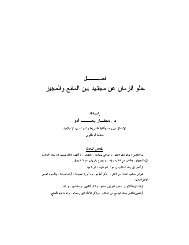Anderson's Winesburg, Ohio: The Individual in the Village Dr ...
Anderson's Winesburg, Ohio: The Individual in the Village Dr ...
Anderson's Winesburg, Ohio: The Individual in the Village Dr ...
Create successful ePaper yourself
Turn your PDF publications into a flip-book with our unique Google optimized e-Paper software.
<strong>Anderson's</strong> <strong>W<strong>in</strong>esburg</strong>, <strong>Ohio</strong>: <strong>The</strong> <strong>Individual</strong> <strong>in</strong> <strong>the</strong> <strong>Village</strong><br />
Anderson did not label <strong>W<strong>in</strong>esburg</strong> a novel. <strong>The</strong> book has no one<br />
central protagonist. Yet, it has always been treated as a unified work that<br />
has <strong>the</strong>matic unity, susta<strong>in</strong>ed tone, and one narrative consciousness<br />
<strong>in</strong>form<strong>in</strong>g <strong>the</strong> reader about <strong>the</strong> secrets of <strong>the</strong> <strong>in</strong>habitants of <strong>the</strong> town. <strong>The</strong><br />
different chapters have titles and <strong>the</strong>y deal with different characters.<br />
<strong>The</strong>y can be seen as separate short stories, and are often published<br />
separately as autonomous units. However, <strong>the</strong> <strong>in</strong>tertw<strong>in</strong><strong>in</strong>g stories of<br />
<strong>the</strong>se characters, <strong>in</strong> terms of <strong>the</strong>me and treatment and <strong>in</strong> <strong>the</strong> appearance of<br />
many of <strong>the</strong> characters <strong>in</strong> more than one story, argues for <strong>the</strong> treatment of<br />
<strong>the</strong> book as a unified work. <strong>The</strong> <strong>in</strong>tertextuality of <strong>the</strong> stories is evident<br />
throughout. Some of <strong>the</strong> stories can be sequenced differently and yet <strong>the</strong><br />
overall effect would rema<strong>in</strong> <strong>the</strong> same. "Departure," is an exception s<strong>in</strong>ce<br />
it gives <strong>the</strong> narrative its closure and thus cannot be sequenced differently<br />
without chang<strong>in</strong>g <strong>the</strong> impact of <strong>the</strong> work. However, whe<strong>the</strong>r "<strong>Dr</strong><strong>in</strong>k" or<br />
"Adventure" come before or after "Death" does not greatly affect <strong>the</strong><br />
overall impact of each. <strong>The</strong> effect <strong>the</strong>se stories have on <strong>the</strong> reader is<br />
achieved cumulatively and not <strong>in</strong>crementally. Whe<strong>the</strong>r read<strong>in</strong>g <strong>the</strong><br />
chapters separately or as a group <strong>the</strong> readers would receive essentially <strong>the</strong><br />
same impact. Yet, of this collection, no story is so dependent on <strong>the</strong><br />
o<strong>the</strong>rs that it would be un<strong>in</strong>telligible if read alone. One can, however, ask<br />
about <strong>the</strong> reason Anderson put his narrative <strong>in</strong> this form.<br />
In most chapters, different moments <strong>in</strong> <strong>the</strong> lives of <strong>the</strong> characters<br />
happen simultaneously and segment<strong>in</strong>g <strong>the</strong>se moments <strong>in</strong>to different<br />
chapters highlights <strong>the</strong>se moments. In fact, this segmentation highlights<br />
<strong>the</strong> separateness of <strong>the</strong> characters and <strong>the</strong>ir liv<strong>in</strong>g <strong>in</strong> <strong>the</strong>ir own <strong>in</strong>dividual<br />
worlds. In each of <strong>the</strong>se stories, Anderson’s descriptions seem at first<br />
glance to be only attempt<strong>in</strong>g to give <strong>the</strong> background for <strong>the</strong> action that is<br />
tak<strong>in</strong>g place or will take shape. <strong>The</strong> reader gradually sees that <strong>the</strong><br />
descriptions that are abundant throughout <strong>the</strong> book serve to heighten <strong>the</strong><br />
reader's awareness of <strong>the</strong> moment. <strong>The</strong> scenes dramatize <strong>the</strong> moment that<br />
seems as if it is always <strong>the</strong> immediate present leav<strong>in</strong>g <strong>the</strong> future and <strong>the</strong><br />
past beyond any significance. <strong>The</strong> reader encounters one character at one<br />
moment struggl<strong>in</strong>g with his/her separateness and <strong>in</strong>ability to achieve<br />
understand<strong>in</strong>g by o<strong>the</strong>rs or to th<strong>in</strong>k that success is achievable.<br />
Anderson emphasizes <strong>the</strong> importance of <strong>the</strong> present moment over<br />
any o<strong>the</strong>r. It is <strong>in</strong> this moment that he highlights <strong>the</strong> details of life, <strong>the</strong><br />
٤٠

















